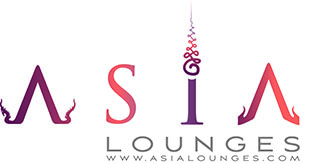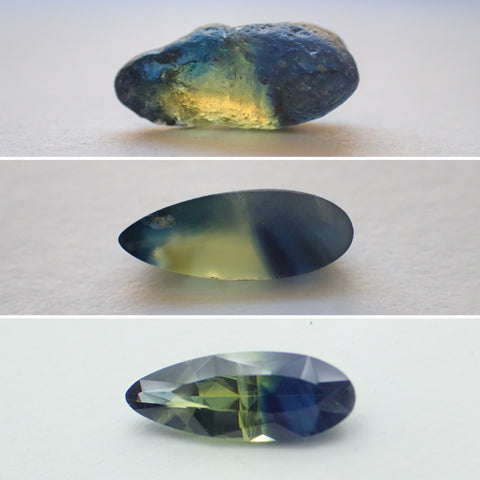Hey Loungers,
As you may have noticed, we have had a fair few gem cutters coming through our columns recently. Today, we interview the newly appointed president of the South Australian division of the G.A.A. (Gemmological Association of Australia), Madame the President Laura Phillis!
Laura is a famed lapidary artist, whom is more widely known by her company name on Instagram: Tatum Gems, who’s made a name for herself for coming up with brand new gem designs as well as for being a gemmological teacher in her native Australia.
We had the opportunity of meeting her recently during the 2020 edition of the Tucson show where she agreed to answer to our questions.
Laura, the floor is yours,
Discover Laura Phillis and her creations at Tatum Gems - Photo Credit: Tatum Gems
AsiaLounges: First of all, thank you very much Laura for agreeing to joining us today in the Lounges and to answer to our questions. We’ll start with the usual if you don’t mind, tell us more about yourself. Who are you Laura Phillis?
Laura Phillis: Hi Simon, thanks for having me.
I am a professional gem cutter for 6 years, trained under a master cutter, Scott Langford, here in Adelaide where I am based. During my training I learnt a lot about repair work and custom cutting including: faceting, cabbing, inlay jewellery, and all other combinations one can think of.
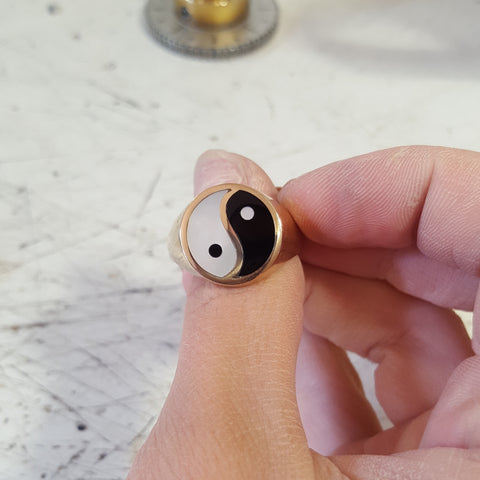
Example of Inlay Jewellery - Photo Credit: Tatum Gems
I now run my own business, Tatum Gems, cutting my own stones and creating my own designs. I have been running my business for about 3 and a half years now, but I have worked in numerous areas of the jewellery trade for 10 years. I worked in jewellery sales, including retail, wholesale and secondhand, I worked with manufacturing jewellers in small businesses, to production lines, quality control, and grading diamonds in larger companies. All before I discovered the art of gem cutting and fell in love with it. I also graduated Gemmology in 2014 through the GAA, and then went on to teach part time for the GAA and got involved in state and federal committees, which brings me to President today!
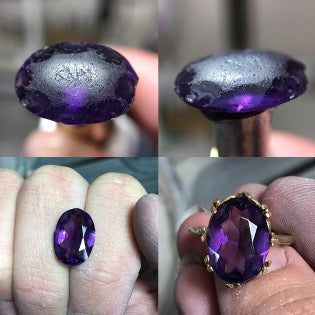
Here is an example of Laura's work on an amethyst - Photo Credit: Tatum Gems
AsiaLounges: Many are the ways that bring people to the gem world, whether it is family, early passion or a chance encounter with a shiny rock. What made you want to enter the trade and why did you decide to enter the trade from the Lapidary Arts side of the business?
Laura Phillis: I think my story is full of chance encounters with the right people along the way. My family is not involved with gemstones or jewellery, and growing up I never really had any kind of connection to jewellery, I was a tomboy (just to shock some people out there!). I started working in a second hand store in 2010, and at the time knew nothing about jewellery or metals, but was a keen learner of anything you put in front of me. So I really learnt everything from scratch; what is 9 Kts and 18 Kts, why is gold sometimes white or pink, not all red gemstones are the same gemstone. I was a fast learner, and one day a customer suggested I should study gemmology, he thought I’d be very good at it. So I studied a few short gemmology courses before I went on to study the 2 year part time diploma, and this same gentleman turned out to be my lecturer! During my studies of gemmology I was looking at career options, I wanted to be more than just a salesperson in a shop. A friend told me about her mother-in-law who was a hobby lapidarist and silversmith with a local gem and mineral club, so I decided to meet her and try my hand at that and see if jewellery might be my next career move. I made a silver pendant for my mum for Christmas that year, and I cut, soldered, and hand polished the silver, I cabbed a piece of jasper and then set the gem all by myself. From this experience I learnt 2 things. I did not want to be a jeweller, I didn't enjoy how tedious and delicate working with metal could be, but I discovered I loved cutting gemstones instead! And from there my thirst was born. I wanted to take up learning lapidary at my local gem and mineral club but unfortunately it clashed on the same nights as my gemmology classes, so the only other avenue I could think of was to approach the only professional cutter we have in South Australia, Scott Langford, and beg him to teach me and employ me, which he did.
AsiaLounges: As we mentioned in the introduction you are not only a lapidary artist but also a gemmology teacher. The question that comes to mind is why a gemmology teacher rather than a lapidary teacher? Not that they cannot coexist but isn’t your specialty gem cutting?
Laura Phillis: I guess there’s a few reasons for this. I enjoy teaching Gemmology which is perhaps a wider umbrella, and I teach for an existing organisation, where a course structure and course notes have already been established. In Australia there are no formal lapidary schools that teach an apprenticeship, and its not a skill that can be easily mastered or taught to large groups like gemmology can be, its a lot more hands-on and is better taught 1-on-1 or 2-on-1 in my opinion. There are lapidary clubs that teach these classes to hobbyists, but as I never learnt at that level, I wouldn't be the best person to teach at that level. Because I run my business as a cutter and work for myself full time, I think teaching gem cutting outside of those hours would take away from my passion. I enjoy teaching and learning about gemmology in my spare time as it helps further my own education and skills as a gem cutter I suppose.
AsiaLounges: On your website you mention that you have created your first design in 2014, the Lataphilly Octavia Cut, if I’m not mistaken. Tell us more about it? What makes it special and why create this design to begin with? How do you create a new design? I mean, what inspires you to create a new cutting pattern?
Laura Phillis: I gained a really broad skillset of cutting when I learnt to repair gems. You have to be adaptable, sometimes tweaking things or adding in an extra facet here or there to remove or hide a chip while still keeping the same size and not losing too much weight. As my skills grew, my love for gem cutting became more about challenging myself, and this skill of adaptability turned into me creating my own faceting designs on my personal pieces of rough because I enjoyed the creative challenge of making things up! With my designs, I like to follow the natural shape of the gem I’m working with because that's where I draw my inspiration from, but also, it saves weight on the gem if I cut it close to the dimensions of the rough too.
Example of bicolour rough sapphires cut by Tatum Gems - Photo Credit: Tatum Gems
Creating a new design takes a bit more concentration though, I need to sit down and either think about a shape I’d like to cut, and map it out from there, or more often that not, I cut the girdle and main facets in to give me an idea, and from there draw lines on the stone in pencil to see the type of facet patterns and meet points I’d like and then cut from there. I’m a visual person so I need to ‘see’ what it might look like before I cut it. Once I’ve drawn on my pencil lines, I think of it like ‘tracing’ to find the right index and angle to cut in the facet. I’ve never used GemCad or computer software to map out a design but as long as you keep the angles above the critical angle, the finished gem will still reflect and refract light nicely.
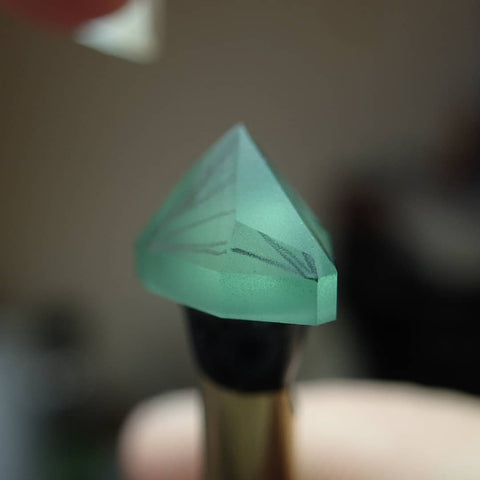
Example of ‘tracing’ pencil lines drawn on a gemstone to visualise where facets and meet points will be cut down. - Photo Credit: Tatum Gems
AsiaLounges: What is your favourite gemstone? Is your favourite gem the one you enjoy the most working with or are they different?
Laura Phillis: Thats a great question, I have not considered if my favourite gem is a favourite because I like to work with it or just because I like it. I suppose my 2 favourite gems are zircon and sapphire. I like zircon a lot because I think the doubling can be really beautiful, and it's such an underrated stone. A lot of the jewellery I’ve had made for myself accidentally happens to often be with zircons. So I like cutting it and wearing it, even from a gemmology point of view it can be interesting because it shows some cool reactions with the spectroscope and UV. As for sapphire, I love it because it comes in just about every colour you could imagine!
Party Australian Sapphire cut by Tatum Gems - Photo Credit: Tatum Gems
I cut a lot of Australian sapphires and a lot of sapphires we have in Australia are parti coloured or bi-colour and always create a really interesting mix of colour, you never know how the stone will turn out. I guess other reasons people may like sapphires is for their durability, but I’m just a fan of colour! And again I suppose gemmologically speaking, gems in the corundum family have some pretty wild and exciting inclusions under the microscope.

Example of Australian sapphire "Before and After" cut - Photo Credit: Tatum Gems
AsiaLounges: Coming back to the lapidary arts, why come up with new designs when classic cuts seem to be in rather high demand in today’s market?
Laura Phillis: I disagree actually. I began cutting unique shapes because that's just what I liked to do to challenge myself, but also because I got bored of repetition with repairing classic cuts. I was constantly repolishing ovals and emerald cuts, and even now I roll my eyes if I have to cut an oval, I did them to death. But, during my time repairing gems a lot of coloured stones that came through were classic cuts because they would fit into a calibrated setting in a piece of jewellery usually with a halo of diamonds around. There was no creativity with mass produced jewellery, and the market was more concerned about diamonds perhaps. But over the past few years I have seen trends shift more, people are daring to have a bit more colour in their jewellery, perhaps a coloured gem halo, or a coloured gem centre with a coloured gem halo, and I’m even seeing more and more manufacturing jewellers dare to be different and use some more unusal shapes to set their work apart from mass producing companies. I think this shift comes more and more as people want their jewellery to be as unique as they are, and don't want something that everyone else has. From a cutters perspective too though, it means that we can use a wider range of odd shaped pieces of rough and salvage more weight cutting a more suitable shape for the chosen piece of rough.
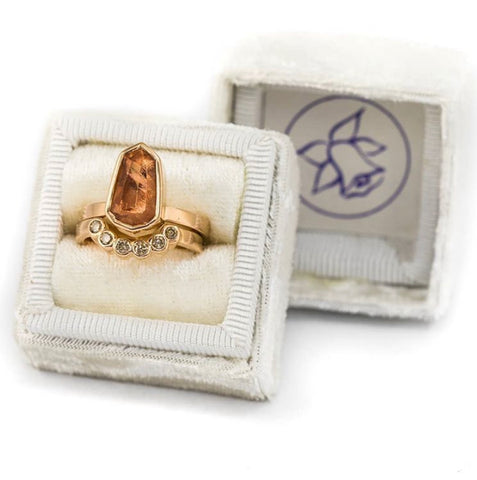
Example of jewellery pieces made by Bluebell Design - Photo Credit: Bluebell Design Jewellery
Certainly my business attract those type of clients that seek the more one-of-a-kind stones or unique shapes, but that doesn't mean that there aren’t other businesses that focus on classic cuts and have the clients who want repeatable shapes and dimensions. After my recent trip to Tucson this year, I believe there is more of a focus on the cutter behind the gem now, not just the jeweller, or designer. Lapidary art is gaining a lot more popularity and fame and we’ve got some great talent in our industry cutting some wonderfully unique designs.
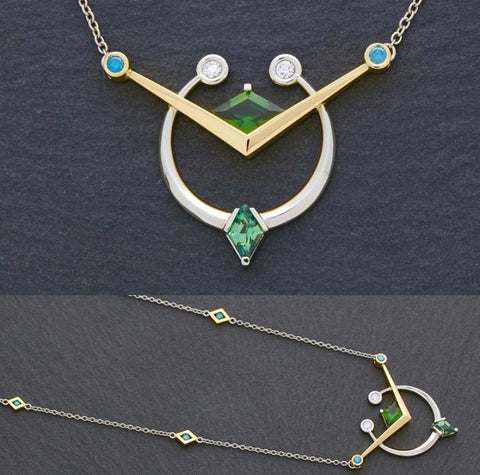
Sapphire and diamond pendant – image courtesy of Raintree
AsiaLounges: One of the talk of the last few years in the trade, at least in Bangkok, is whether such and such origin or practices are ethical. What is your take on the topic as an Australian gem cutter and gem dealer? As a gemmology teacher?
Laura Phillis: Theres a big debate going on around the word ‘ethical’ or ‘ethically sourced’, and the more I research into it the less I like using the word. Every country has different wages, different cost of living, or trading culture, so while I may judge by my western standards of what is ethical if I were mining in my country, the same standards might be lower in other countries and still be considered ethical practices for those countries. There are certainly unethical trading practices in mining around the world, but sometimes the wages may be less than you or I might earn in a western society, but in a mining area the wages are fair, or other benefits are also provided like healthcare, education, etc.
I have a Sri Lankan friend who employs 100 or more gem cutters in a factory, and he is often proud to tell me how he is helping the community and those families with employment.
One person employed may earn enough to support their whole family and can now pay for the education of their children, and it has a flow on effect. Their wage may be low compared to western standards but that is helping the economy and the community and I think that is important.
Some food for thought though, when people think of unethical practices around child labour in developing countries, we do not look at it the same when a minor in a first world country is selling or profiting from the gem industry, we support and embrace it, why?
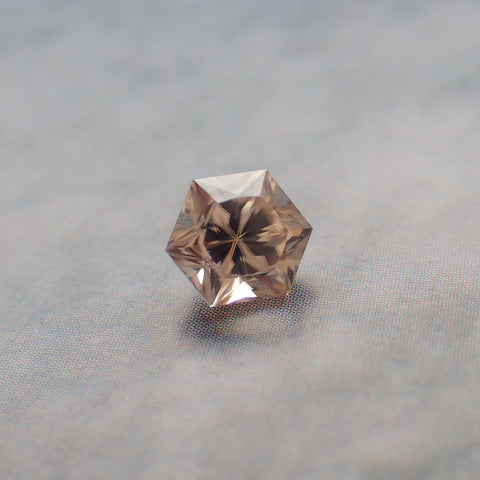
Example of Australian Zircon - Photo Credit: Tatum Gems
Back to the question though, I think traceability is becoming more and more important. If you know the origin of the gem, you can learn more about the mining practices of that country, and can decide from there what you are purchasing and supporting. A lot of mining around the world is from small claims, so if I buy gems from a miner in Australia or USA I know I can pretty confidently say that those stones were ethically sourced and responsibly mined. If I buy gemstones from Tanzania or Madagascar for example, that stone may have been mined by a miner, then sold to a gem merchant, then sold by a broker to a gem rough dealer who may travel to a country near me where I then buy it and then on sell to my customer, and so on. When a stone passes through that many hands its impossible to know confidently if that parcel of stones was mined ethically or responsibly, but knowing the origin helps. Where possible I like to buy direct from the miners or owners of the mine, and its something I'm focusing on more and more when I go on buying trips, as it's something I get increasingly asked about.
AsiaLounges: You recently mentioned in a video interview we did in Tucson (Which can be seen on our YouTube channel) that, in your opinion it is capital to be a Gemmologist to be a gem cutter. Can you tell us why exactly you think, thought ?, that ? And what is your opinion of the vast majority of Sri Lankan or Thai gem cutters that are not gemmologists yet highly successful and demanded cutters?
Laura Phillis: I believe it's incredibly important as a gem cutter to understand the science of gemmology, or at least the basic principals of it. This includes things like the properties of light and how it reacts with gemstones, the chemistry of gemstones and what causes color and how it can be optimised in a gem, and also the crystallographic properties of different gems. Understanding this can help a gem cutter understand about what causes windows in gemstones, how to avoid cutting on a cleavage plane in a Topaz for example, and how to orientate a parti coloured gem or gem with zoning. If you are a gem cutter who cuts a wide range of different gem materials then this is important, because every gemstone has different properties and parameters.
In large cutting factories in Sri Lanka or Thailand for example, they would have cutters who specialise in cutting certain gems, someone who is an expert with cutting tourmalines and knows how to get the best weight return from a crystal and eliminate dark colour from the C-axis, someone who specialises in cutting sapphires who can position the color zoning optimally in the pavilion of the stone to get the best saturation of color in the finished gem, and so on. These type of cutters may have been cutting for decades and have learnt to cut only a select few different types of gemstones, the same can be said close to any mining areas around the world though.
Sapphire mining in Queensland, Australia, and emerald mining in Columbia are also examples. Cutters in Columbia who are based close to the mining areas are specialised in cutting emeralds because that's the majority of what they see, some cutters there have never cut a topaz, or a sapphire and don't know the chemical, optical, and their crystallographic properties, and therefore how to best cut them.
Another really important reason for studying gemmology if you are a gem cutter, and are buying gems, is to understand what you are buying. Sometimes a parcel of gems could have a mix of gemstones in them, this can happen by accident, or it could happen on purpose by the dealer or miner if they want to mix fakes in with a parcel of natural gems or a cheaper gemstone mixed in a more expensive parcel. For example selling a parcel of aquamarines with some cheaper topaz thrown in.
Understanding gemmology can help you differentiate the crystal shape of different gems in the rough, and also using gemmological tools (and knowing how to use them correctly) can help separate what gems you may have in a parcel by their optical and chemical properties, this applies to rough gems or cut gems.
AsiaLounges: We are slowly approaching the end of our interview and, as it is customary with our interviews, I’d like to ask you to give three advices to any of our readers, the Loungers who’d like to follow in your footsteps and 3 books that you believe any gem lover should have in their library.
Laura Phillis: People often ask me how they can learn gem cutting, and I don't have an easy answer for this. There are not a lot of places where you can learn it professionally from.
A lot of people learn through lapidary clubs, or are self taught, but my easiest piece of advice if you want to try it out and see if it's for you, look up a local gem and mineral/ lapidary club in your state or country. Or, if you are willing to travel to learn you can also travel to the Institute of Gem Trading in Bangkok and learn some more skills there.
A great book recommendation that goes along with the previous advice is the Vargas books. Glenn and Martha Vargas have written some great books for lapidarists. Some with faceting designs, some with general reference information for cutters. They are out of print and sometimes hard to find, but worth their weight in gems as all best out of print books are.Therefore, I’d recommend their ‘Faceting for amateurs’ because it has some great information about the critical angles of most gemstones, and how to polish them, etc which is a good start for any lapidarist. I still reference this book from time to time myself.
If you are interested in gemstones, I highly recommend learning about gemmology!
I thoroughly enjoyed it, the Australian GAA course is a bit more science based than the American GIA course is I believe, but I enjoyed that element to it. I found the chemistry of gems and how they react with light to be fascinating, but mostly I fell in love with looking at inclusions under the microscope, I can get lost for hours. One book I would highly recommend for this reason is what I refer to as the bible, and that is the Photoatlas of Inclusions in Gemstones vol. 1 by Eduard j. Gubelin and John I. Koivula. It has some incredible images of inclusions but also documents the localities that some of these inclusions can be found in.
And lastly, if you are already in the industry, or are passionate about gems or gemmology, spread the Word! Get involved! We need to talk about this more and grow our industry for the better. Get connected and share your knowledge or skills or passion with others, and who knows, maybe you might inspire the next generation, like someone did for me 10 years ago.
AsiaLounges: Last but not least, please let us know where can the Loungers reach you and follow your work should they wish to contact you directly?
Laura Phillis: If you’d like to follow my work or get in touch, you can find me on my business pages on Instagram or Facebook under the name Tatum Gems, or feel free to visit my website www.tatumgems.com.au
AsiaLounges: Thank you very much Laura for being with us today, I am convinced that our readers, the Loungers, have enjoyed this interview as much as we did enjoy writing these lines.
As for us, we will meet you again soon in the Lounges with more exciting content! If you have enjoyed this interview please let us know by liking, commenting and sharing our work with your family and friends on your favourite social media platform. Don't forget that you can also support A Gem Dealer's Journal through our Patreon's Page. It helps us a lot and takes but a second!
Should you have any questions or topic that you’d like us to research for a future interviews and articles, feel free to let us know by contacting us at simon@asialounges.com, it is always a pleasure to dig further into the world of gems and gemmology!
For all the rest, feel free to take a look at our gem and jewellery collection as well as to contact us should you be interested in getting one of our famed bespoke pieces of AsiaLounges Jewellery.
See you again in the Lounges,
